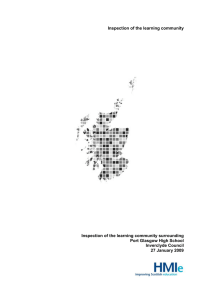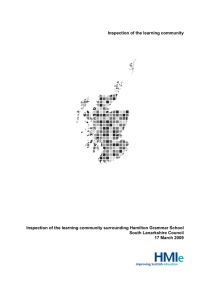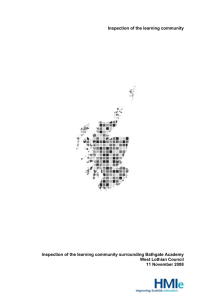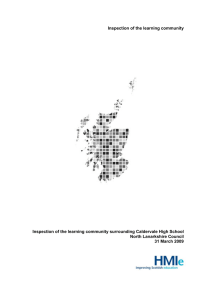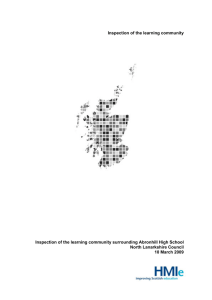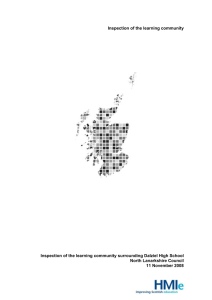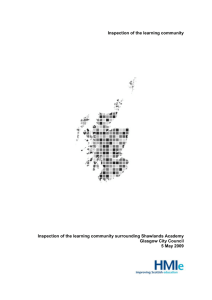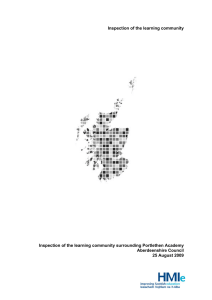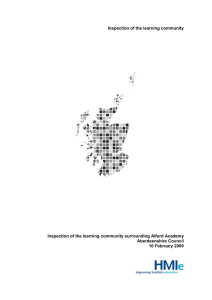Inspection of the learning community Inspection of the learning community surrounding
advertisement
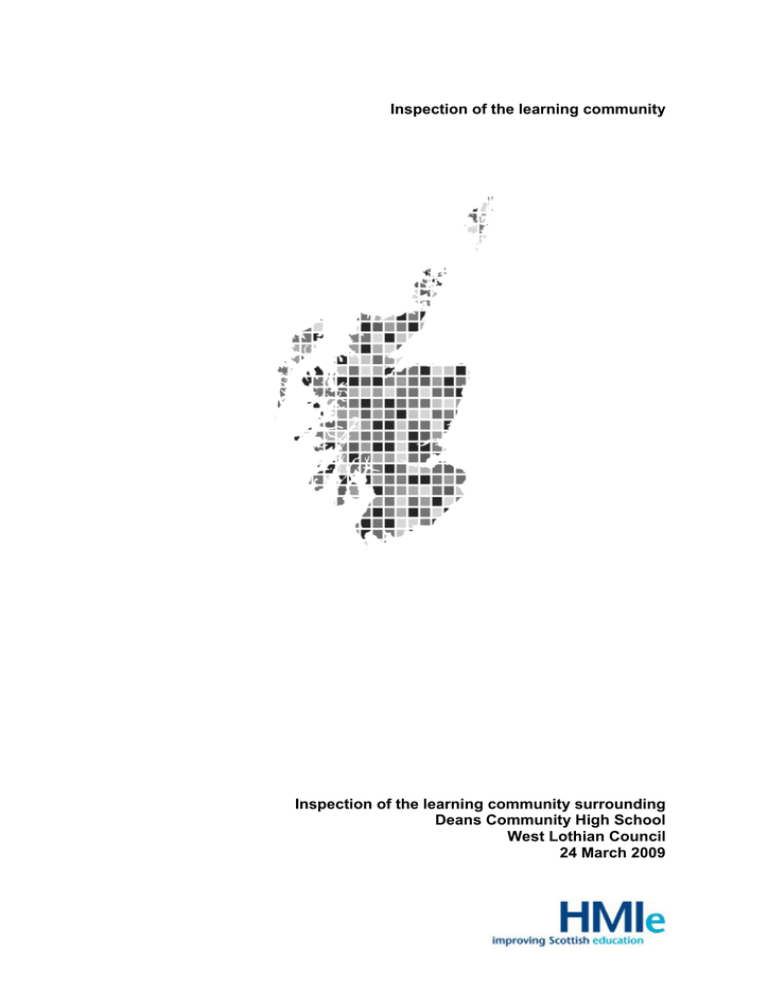
Inspection of the learning community Inspection of the learning community surrounding Deans Community High School West Lothian Council 24 March 2009 Contents 1. About the report 2. The learning community 3. Particular strengths of the learning community 4. Examples of good practice 5. How well do participants learn and achieve? 6. How well does CLD help the community to develop? 7. How effective are providers in improving the quality of services? 8. Do CLD providers have a clear sense of direction? 9. What happens next? 1. About the report This report tells you about community learning and development (CLD) activities in the communities surrounding Deans Community High School. It complements a separate report on the school. We explain how well people involved in community learning activities do in a wide range of experiences, and the quality of learning activities on offer to them. We describe how communities can influence decision-making and how they can respond positively to their own issues. We also talk about how organisations work together and how they improve lives in local communities. Finally, our report looks at the vision for the area, and how well all organisations and the community are working together to achieve it. 2. The learning community The learning community around Deans High School includes the neighbourhoods of Knightsridge, Carmondean and Deans within North Livingston. Knightsridge and Deans both contain data zones in the lowest 15% in Scotland. The area is relatively well served for facilities in terms of shops, garage, health centre and transport links for Bathgate, Edinburgh and Glasgow. The proportion of jobless people is lower than the Scottish average and the rest of West Lothian overall, but is higher than both in relation to the level of jobless young people. 3. Particular strengths of the learning community • High levels of facilities and activities. • Focus on vulnerable adult learners. • Very inclusive community groups. 1 4. Examples of good practice • The Cool Down Crew offers opportunities for targeted young people to engage in high quality partnership delivery by the Fire and Rescue service and youth workers. • Delivery of the Youth Voters initiative ensures that young people have a clear understanding of the importance of being active citizens. • The food Co-ops operate very successfully locally and volunteers are gaining a broad range of skills and experience while raising awareness of healthy eating across the community. • The Deans Club offers very effective learning opportunities for participants with mental health issues. By visiting www.hmie.gov.uk you can find out more about these examples of good practice. 5. How well do participants learn and achieve? Most organisations and projects are clearly having a positive impact on participants. The overall use of data to inform planning and priorities is not systematic. Some organisations and activities including West Lothian Youth Action Project (WLYAP) and CLD adult literacies can show progress and trends over time. In a lot of activities there is a focus on looking at numbers of learners rather than on the overall quality of the learners’ experience. There is no overall sense that providers operating in the learning community have a deep understanding of the needs of local residents. Those delivering CLD need to be more systematic in tracking learner progression and identifying clear targets for individuals and communities. Adults Most adult learners are increasing in confidence, and feel more active and respected as a result of their engagement in classes and programmes. They are positive about their experiences and learn a range of skills which enhance their employability and wider lives. There is a focus on ensuring that vulnerable learners are able to participate in both targeted and mainstream programmes. Those engaged in the wide range of childcare training are developing additional knowledge and skills which make them much more effective in their working lives. Learners’ achievements are recognised through a range of local and authority-wide celebrations. Guidance and discussion about progression is built into literacies work and works well but is more limited within other aspects of adult learning. Learners are gaining knowledge and skills from the activities they are involved in but some are unclear about the most appropriate next steps for them. 2 There are missed opportunities for effective family learning through the high levels of pre-five work going on in the area and through school links. Young people Young people involved in targeted provision such as The Cool Down Crew and employability programmes are developing a range of skills, gaining confidence and increasing their social awareness. There is a positive impact on transition to senior school for some young people attending CLD service’s Fun Fever. There is a high level of junior work in the area which provides participants with a safe fun environment. There are limited opportunities for progression into relevant and suitable provision for the 14+ age range. Knightsridge adventure playground has recently reopened and is attracting some of this age range but it is too early to assess the impact of this provision. WLYAP meet with young people through their streetwork programme and signpost them to a range of services for support and advice. There is insufficient focus on learning, progression and review in most of the general provision. Young people involved in targeted programmes and activities engage in a range of activities to celebrate their achievement. Accreditation and awards programmes could be more effectively and systematically used in this area. 6. How well does CLD help the community to develop? There is a strong balanced representation of the adult community in community organisations and management committees. These groups and all of the CLD partners would benefit from a more coordinated approach to recruiting and promoting opportunities for volunteers. Young people are engaged in pupil councils and have good links to West Lothian Youth Congress. There are further opportunities to encourage their involvement in other organisations in the wider community. Lots of adults and some primary school children are actively involved in social enterprises, notably the food Co-ops and Credit Union. They are gaining a wide range of skills, knowledge and confidence through this activity and providing important services to vulnerable communities. There have been a number of one-off events such as fun days to encourage local groups and individuals to engage regularly in wider decision-making about their community. 7. How effective are providers in improving the quality of services? The annual report from the CLD service, and local newsletters on developments in Livingston North provide good feedback for local people. The collective training calendar enables staff and volunteers to access appropriate levels of continuous professional development and learn together. Some organisations and services undertake systematic review and regular reflection on their practice, but others do not have this built in as part of their ongoing work. Almost all staff and volunteers are receptive to engaging in reflective practice. The limited joint planning arrangements make it difficult for staff and volunteers to ensure that they are meeting community needs. 3 8. Do CLD providers have a clear sense of direction? While there are good informal links across some groups and agencies there is too little operational engagement of partners at local level. Some of the youth work delivery groups have begun to discuss joint concerns and priorities and this work should be further developed. The overall understanding of the area is limited, with most organisations and departments working to their own priorities rather than working together. The development of the Life Stages model of locality planning is beginning to bring agencies, including schools, services and local groups together to develop a clearer sense of overall needs and direction. 9. What happens next? There are some important improvements needed, but because CLD providers have a good understanding of their strengths and areas for improvement, and communities are achieving well, we have ended the inspection process at this stage. We will monitor progress through our regular contact with the education authority. We have agreed the following areas for improvement with the education authority and its partners. • Greater focus on engaging young people in taking ownership of their learning. • Continue to develop appropriate opportunities for young people over 14. • More systematic use of data about CLD delivery to inform programmes and priorities. • More effective joint- planning across the learning community. Quality indicators help CLD providers and inspectors to judge what is good and what needs to be improved in the work of the school. You can find these quality indicators in the HMIE publication “How good is our community learning and development? 2” The report uses the following word scale to make clear judgements made by inspectors. Excellent Very good Good Satisfactory Weak Unsatisfactory Outstanding, sector leading Major strengths Important strengths with some areas for improvement Strengths just outweigh weaknesses Important weaknesses Major weaknesses 4 HMIE checks five important quality indicators to keep track of how well all Scottish CLD provision is doing. Here are the results for the learning community surrounding Deans Community High. Improvements in performance Impact on young people Impact on adults Impact of capacity building on communities Improving services Managing Inspector: Maureen Mallon 24 March 2009 5 satisfactory satisfactory good satisfactory satisfactory How can you contact us? HMIE has responsibilities to evaluate the quality of pre-school education, all schools, teacher education, community learning and development, colleges and local authorities. We also publish reports of interest to the public and professionals about services for children and evaluate child protection services. From this extensive evidence we are able to give the professional advice needed to support the development of educational policy. For more information about the work of HMIE, including examples of good practice and links to Journey to Excellence, please visit our website at www.hmie.gov.uk. To find out more about inspections go to www.hmie.gov.uk. Please contact the Business Management and Communications Team if you require any of our information available in translated or other appropriate versions. If you wish to comment about any of our inspections, contact us at HMIEenquiries@hmie.gsi.gov.uk or alternatively you should write to Business Management and Communications Team, HM Inspectorate of Education, Denholm House, Almondvale Business Park, Almondvale Way, Livingston EH54 6GA. Our complaints procedure is available from Rona Littleproud, HM Inspectorate of Education, Denholm House, Almondvale Business Park, Almondvale Way, Livingston EH54 6GA or phone 01506 600258 or from our website at www.hmie.gov.uk. If you are not satisfied with the action we have taken at the end of our complaints procedure, you can raise a complaint with the Scottish Public Services Ombudsman (SPSO). The SPSO is fully independent and has powers to investigate complaints about Government departments and agencies. You should write to the SPSO, Freepost EH641, Edinburgh EH3 0BR. You can also telephone 0800 377 7330, fax 0800 377 7331 or email ask@spso.org.uk. More information about the Ombudsman’s office can be obtained from the website www.spso.org.uk. Want to join us? In addition to HMI, inspection teams often include people who are not HMI but are involved directly in education. They are called Associate Assessors and most work in community learning and development. Most inspection teams also include a member of the public called a Lay Member. More information about how you can become an Associate Assessor or Lay Member is available at www.hmie.gov.uk. Crown Copyright 2009 HM Inspectorate of Education

